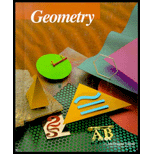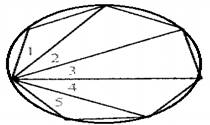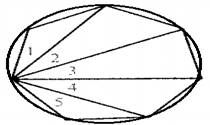
a.
To find:The reason thatthe numbered
a.
Answer to Problem 24WE
Numbered angles are congruent because their corresponding arcs are also congruent.
Explanation of Solution
Giveninformation: A regular polygon with 7 sides is given as shown in below figure,

Concept used:Use following properties of a
(i) By theorem 9.4, congruent chords have congruent arcs.
(ii) In a circle, congruent arcs subtend congruent inscribed angles on their remaining arcs.
To prove: In given figure, all number angles are congruent.
Key steps of proof of case III:
- Circumscribe a circle along given regular polygon with 7 sides.
- Thus, congruent sides of regular polygon are congruent chords of this circle.
- By above (i) concept, their corresponding arcs are also congruent.
- Now as these congruent arcs make numbered inscribed angles, by above concept (ii), these numbered angles will also be congruent.
Conclusion: Thus,It concludes that all numbered angles are congruent as their corresponding arcs of circumscribed circle are also congruent.
b.
To find:If angles inscribed by arcs of a regular polygon are congruent, irrespective of its total sides in it.
b.
Answer to Problem 24WE
In a regular polygon of any number of sides, the inscribed angles by its arcs are always congruent.
Explanation of Solution
Giveninformation: A regular polygon with 7 sides is given as shown in below figure,

Concept used:Use following properties of a circle,
(i) By theorem 9.4, congruent chords have congruent arcs.
(ii) In a circle, congruent arcs subtend congruent inscribed angles on their remaining arcs.
To prove: If result of part (a) is applicable to a regular polygon with any number of its sides.
Key steps of proof of case III:
- Circumscribe a circle along a regular polygon with any number of sides.
- Thus, congruent sides of regular polygon are congruent chords of this circle.
- By above (i) concept, their corresponding arcs are also congruent.
- Now as these congruent arcs make numbered inscribed angles, by above concept (ii), these numbered angles will also be congruent.
Conclusion: Thus, It concludes that all numbered angles are congruent as their corresponding arcs of circumscribed circle are also congruent. And it does not depend on number of sides of the regular polygon.
Chapter 9 Solutions
McDougal Littell Jurgensen Geometry: Student Edition Geometry
Additional Math Textbook Solutions
Thinking Mathematically (6th Edition)
A Problem Solving Approach To Mathematics For Elementary School Teachers (13th Edition)
Algebra and Trigonometry (6th Edition)
Elementary Statistics: Picturing the World (7th Edition)
College Algebra with Modeling & Visualization (5th Edition)
A First Course in Probability (10th Edition)
- 5. 156 m/WXY = 59° 63 E 7. B E 101 C mFE = 6. 68° 8. C 17arrow_forward1/6/25, 3:55 PM Question: 14 Similar right triangles EFG and HIJ are shown. re of 120 √65 adjacent E hypotenuse adjaca H hypotenuse Item Bank | DnA Er:nollesup .es/prist Sisupe ed 12um jerit out i al F 4 G I oppe J 18009 90 ODPO ysma brs & eaus ps sd jon yem What is the value of tan J? ed on yem O broppo 4 ○ A. √65 Qx oppoEF Adj art saused taupe ed for yem 4 ○ B. √65 29 asipnisht riod 916 zelprisht rad √65 4 O ○ C. 4 √65 O D. VIS 9 OD elimiz 916 aelonsider saused supsarrow_forwardFind all anglesarrow_forward
- Find U V . 10 U V T 64° Write your answer as an integer or as a decimal rounded to the nearest tenth. U V = Entregararrow_forwardFind the area of a square whose diagonal is 10arrow_forwardDecomposition geometry: Mary is making a decorative yard space with dimensions as shaded in green (ΔOAB).Mary would like to cover the yard space with artificial turf (plastic grass-like rug). Mary reasoned that she could draw a rectangle around the figure so that the point O was at a vertex of the rectangle and that points A and B were on sides of the rectangle. Then she reasoned that the three smaller triangles resulting could be subtracted from the area of the rectangle. Mary determined that she would need 28 square meters of artificial turf to cover the green shaded yard space pictured exactly.arrow_forward
- 7. 11 m 12.7 m 14 m S V=B₁+ B2(h) 9.5 m 16 m h+s 2 na 62-19 = 37 +, M h² = Bu-29arrow_forwardwhat would a of a interscribed angle be with an arc of 93 degrees and inside abgles of 111 and 98arrow_forwardPlease complete through GeoGebra and present the screenshots of the results. Thanks! (This supports on how to submit it.)arrow_forward
 Elementary Geometry For College Students, 7eGeometryISBN:9781337614085Author:Alexander, Daniel C.; Koeberlein, Geralyn M.Publisher:Cengage,
Elementary Geometry For College Students, 7eGeometryISBN:9781337614085Author:Alexander, Daniel C.; Koeberlein, Geralyn M.Publisher:Cengage, Elementary Geometry for College StudentsGeometryISBN:9781285195698Author:Daniel C. Alexander, Geralyn M. KoeberleinPublisher:Cengage Learning
Elementary Geometry for College StudentsGeometryISBN:9781285195698Author:Daniel C. Alexander, Geralyn M. KoeberleinPublisher:Cengage Learning

